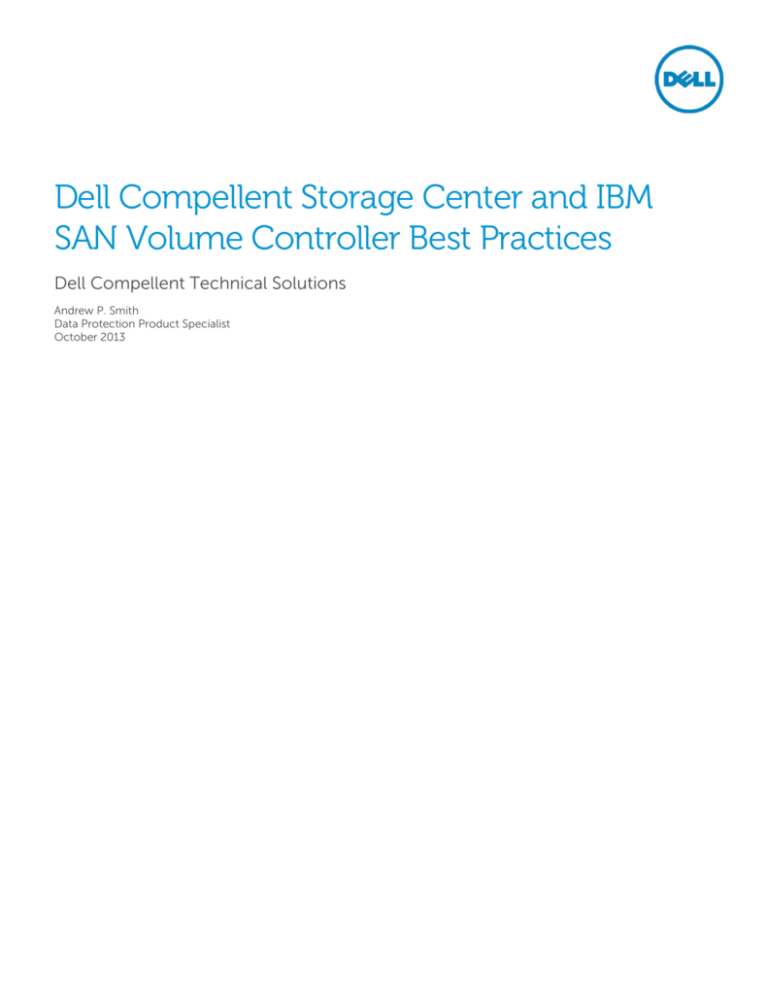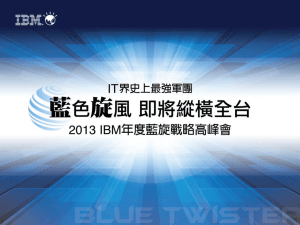
Dell Compellent Storage Center and IBM
SAN Volume Controller Best Practices
Dell Compellent Technical Solutions
Andrew P. Smith
Data Protection Product Specialist
October 2013
Revisions
Date
Description
October 2011
Initial release
October 2013
Updated for SCOS v6.3.x and SC8000
© 2013 Dell Inc. All Rights Reserved. Dell, the Dell logo, and other Dell names and marks are trademarks of Dell Inc. in
the US and worldwide. All other trademarks mentioned herein are the property of their respective owners.
2
Dell Compellent Storage Center and IBM SAN Volume Controller Best Practices
Table of contents
Revisions ............................................................................................................................................................................................. 2
Executive summary .......................................................................................................................................................................... 5
Audience ............................................................................................................................................................................................. 6
Purpose ............................................................................................................................................................................................... 6
Customer support ............................................................................................................................................................................. 6
Important notes ................................................................................................................................................................................ 7
1
Hardware/software versions .................................................................................................................................................... 8
2
Terms ........................................................................................................................................................................................... 9
General.............................................................................................................................................................................. 9
2.2
IBM ..................................................................................................................................................................................... 9
2.3
Dell Compellent .............................................................................................................................................................. 9
3
Configuring the Fabric ............................................................................................................................................................ 10
4
Configuring the Dell Compellent SAN recommendations .............................................................................................. 12
5
6
3
2.1
4.1
Server object definitions for SVC ............................................................................................................................... 12
4.2
Presenting volumes to the SVC .................................................................................................................................. 12
4.3
Solid-state drive (SSD) usage with the SVC .............................................................................................................. 13
4.4
Quorum disks ................................................................................................................................................................ 13
4.5
Import volume to SVC using Image Mode ............................................................................................................... 13
4.6
Using SVC Volume Mirror feature with multiple Storage Center systems ......................................................... 13
4.7
IBM SAN volume controller recommendations ...................................................................................................... 14
4.8
MDisk pools .................................................................................................................................................................... 14
Host connection to an SVC using a Dell Compellent Storage Center .......................................................................... 15
5.1
VDisk setup using Storage Center MDisks ................................................................................................................ 15
5.2
Dell Compellent SAN features with the IBM SVC .................................................................................................... 15
5.3
Data Progression ........................................................................................................................................................... 16
5.4
Data Instant Replay ....................................................................................................................................................... 16
5.5
Thin provisioning ........................................................................................................................................................... 16
5.6
LUN expansion .............................................................................................................................................................. 17
5.7
Copy/Mirror/Migrate .................................................................................................................................................... 17
5.8
Volume import............................................................................................................................................................... 17
Conclusion ................................................................................................................................................................................ 18
Dell Compellent Storage Center and IBM SAN Volume Controller Best Practices
4
A
Appendix .................................................................................................................................................................................... 19
B
Additional resources................................................................................................................................................................ 25
Dell Compellent Storage Center and IBM SAN Volume Controller Best Practices
Executive summary
This document contains best practices and recommendations when using the Dell Compellent Storage
Center (SC) as backend storage for the IBM SAN Volume Controller (SVC).
The IBM SAN Volume Controller is a storage virtualization platform that enables a single source for control
of storage resources to help support enhanced business application availability and improved resource
utilization. From a single management interface, the storage admin can deploy and manage storage
capacity to end-system hosts utilizing multiple backend storage platforms. The IBM SVC consists of at
least two nodes that comprise a clustered I/O group, and can scale up to four 2-node I/O group pairs.
This document assumes the Storage Center SAN and SAN Volume Controller are already configured and
functional in the reader’s environment. This document does not cover the setup of the Storage Center or
SAN Volume Controller, and assumes the reader is familiar with the setup of each platform respectively.
This document is not intended to replace or take precedence over any IBM resources or Dell Compellent
product documents.
For the Dell Compellent Storage Center to be utilized as storage by the SVC, the Storage Center must be
configured to present volumes to the storage node clusters as if they were servers. The SVC then
virtualizes the storage for use by servers configured to connect to the SVC.
5
Dell Compellent Storage Center and IBM SAN Volume Controller Best Practices
Audience
The audience for this document is assumed to be mid-level and higher storage administrators who are
responsible for the management of IBM SAN Volume Controller systems that use Dell Compellent SANs
for back-end storage controller(s).
Purpose
This document provides an overview of the best practices advised by Dell Compellent when using Storage
Center v5.4.x and v5.5.x with IBM SAN Volume Controller (SVC) v6.2 and Dell Compellent Storage Center
v6.3.x with SVC v7.1.0.x and higher.
Customer support
Dell Compellent provides live support 1-866-EZSTORE (866.397.8673), 24 hours a day, 7 days a week, 365
days a year. For additional support, email Dell Compellent at support@compellent.com. Dell Compellent
responds to emails during normal business hours.
6
Dell Compellent Storage Center and IBM SAN Volume Controller Best Practices
Important notes
Note: Dell Compellent provides level 2 support for a Storage Center that is used with an IBM SVC.
Therefore, any issues with storage presentation to a server should generate a support call to IBM first. If
the issue turns out to involve the Storage Center, IBM will then involve Dell Compellent.
Note: The customer must follow IBM guidelines and requirements for cabling and zoning the SVC.
These are spelled out in the IBM System Storage SAN Volume Controller Software Installation and
Configuration Guide and SAN Volume Controller Best Practices and Performance Guidelines. These and
other SVC documents can be obtained in PDF form for free from IBM by going to the IBM support site for
the SVC (http:\\www.ibm.com/storage/support/2145) under “Documentation” section.
Note: Please check the Dell Compellent Knowledge Ccenter and review any Copilot Services Technical
Alerts (CSTA) for the IBM SVC and/or your specific operating system BEFORE attempting any
configuration additions or changes.
Note: Dell Compellent does not recommend or endorse using the SVC in any way that may conflict with
IBM’s published requirements. If there are questions about usage that have not been addressed in this
document, reference the IBM documentation for standard practices.
7
Dell Compellent Storage Center and IBM SAN Volume Controller Best Practices
1
Hardware/software versions
The utilization of the IBM SVC in front of a Dell Compellent Storage Center has been certified to work by
IBM on the following code releases:
Dell Compellent Storage Center v5.4.x and higher requires SVC v6.2.0.3 and higher.
Dell Compellent Storage Center v5.2 and v5.3 is supported on SVC v5.1.0.6 and higher.
Dell Compellent Storage Center v6.3.x is supported on SVC v7.1.0.x and higher.
In addition, Dell Compellent has tested the above versions using Storage Center SAN models SC030 and
SC040 in both Legacy Port Mode and Virtual Port Mode (Virtual Port Mode requires N_Port ID
Virtualization (NPIV) compatibility). The SC8000 has been tested in Virtual Port Mode. The information in
this paper is derived from using the above hardware and software versions and configurations.
8
Dell Compellent Storage Center and IBM SAN Volume Controller Best Practices
2
Terms
2.1
General
LUN – Logical Unit Number, a generic term for storage presented to a server via Fiber Channel or iSCSI.
Quorum Disk – Tie breaking device used when there are systems clustered together.
2.2
IBM
Image Mode – any incoming LUN that is presented directly to a server without using any of the SVC’s
management features.
Managed Mode – any incoming LUN that is utilized inside an MDisk group that is not presented directly to
a server.
MDisk – “Managed Disk”, an incoming LUN presented by a storage system (e.g., Storage Center) to the
SVC.
VDisk – “Virtual Disk”, an outgoing LUN presented by an SVC to a host connected to an SVC.
2.3
Dell Compellent
Front End Primaries – Fiber Channel port intended for active use with systems.
Front End Reserves – Fiber Channel port intended for standby use with systems.
N_Port ID Virtualization (NPIV) - When this is enabled on the Dell Compellent Storage Center SAN and
connected Fiber Channel switches, all front-end Fiber Channel ports are in an active state and utilized for
I/O between the SAN and IBM SVC.
Volume – Logical volume created on a Dell Compellent Storage Center for use by a server.
9
Dell Compellent Storage Center and IBM SAN Volume Controller Best Practices
3
Configuring the Fabric
Although the Dell Compellent Storage Center and IBM SVC solutions provide multiple controller & node
redundancies, it is also recommended that there be two separate fabrics provided by two separate Fiber
Channel switch networks. The IBM SVC and Storage Center ports should be equally balanced across these
two fabrics. This approach provides I/O redundancy if a single port, switch, node or controller were to fail
within the environment. As is always the case with multi-pathing, it is highly recommended to test failure
scenarios before implementing the design n a production environment. This includes cable, switch and
controller failures.
In order to insure proper discovery of the Dell Compellent SAN as a backend storage controller as well as
providing for failover redundancy, it is necessary to configure the fabric following the recommendations
below. There will need to be several fabric zones configured, and the exact zoning will vary depending on
the port mode in use with Storage Center. At a high-level the zone topology includes an IBM SVC zone, a
Storage Center zone, a “Disk Zone” which enables the connectivity between the SVC and Storage Center,
and a “Host Zone” which enables the connectivity between the SVC and the host system(s).
There should be a fabric zone that contains just the IBM SVC Fiber channel ports. There is no requirement
for hard or soft zoning, so either mode is acceptable.
For use with the SVC, Dell Compellent recommends a similar zoning approach for the Dell Compellent
Storage Center SAN. A zone should be configured that includes just the Storage Center front-end ports.
Based on Compellent best practices, it is recommended that this zone use soft zoning. In addition the Disk
Zone between SVC and Storage Center should not contain any other backend storage controllers.
Table 1
High level fabric zones
Zone
Port
SVC Port Zone
Port
Storage Center
Zone
Port/WWN
Disk Zone
WWN
Host Zone
Port/WWN
SVC WWN Zone
WWN
Comments
Contains only the IBM SVC cluster ports
Contains only the Storage Center front-end ports
Contains the WWNs of the SVC and the front-end ports of the
Storage Center
Contains the host system ports or WWNs and the IBM SVC
ports/WWNs
Contains the WWNs for the SVC cluster ports
The Dell Compellent Storage Center SAN supports two modes of front-end port configuration, legacy and
virtual (NPIV-compatible). Please refer to the section below titled Configuring the Dell Compellent SAN for
further information on these modes.
When zoning the Dell Compellent Storage Center SAN to the IBM SVC a WWN zoning policy should be
utilized. There should be a zone in each fabric that contains the WWNs of the IBM SVC cluster in that
fabric. When the Storage Center is configured in Legacy port mode, (Table 2) the WWNs for the front-end
primary ports should be put into a zone. The WWNs for the front-end reserve ports should be put into a
10
Dell Compellent Storage Center and IBM SAN Volume Controller Best Practices
separate zone. The zone containing the front-end primary WWNs should be zoned to the WWNs for the
IBM SVC cluster to complete the Disk Zone connectivity. Table 1 above provides some further information
on this configuration.
Table 2
Legacy port mode zone examples
Zone
Storage Center – Frontend Primary
(FEP)
Storage Center – Frontend Reserve
(FER)
Zone Type
WWN
WWN
Comments
Contains only the WWNs for the front-end primary
Storage Center ports (Legacy mode)
Contains only the WWNs for the front-end reserve
Storage Center ports (Legacy mode)
SVC WWN Zone
WWN
Contains the WWNs for the SVC cluster ports
Storage Center FEP WWNs to SVC
WWNs
WWN
Contains the WWNs for the front-end primary
(legacy) ports and SVC cluster
When utilizing the Virtual Port Mode configuration of the Dell Compellent Storage Center SAN, the zoning
configuration is similar to the Legacy Port Mode above. However, the NPIV WWNs should be zoned to the
IBM SVC WWNs to complete the Disk Zone connectivity. Port zoning is not supported and will result in
controller discovery failure. Also, please refer to the IBM SVC documentation regarding NPIV support as
well as the switch vendor regarding NPIV support.
Table 3
Virtual Port Mode examples
Zone
11
Zone
Type
Comments
Contains only the WWNs for the front-end ports
physical WWNs
Contains only the WWNs for the front-end ports
virtual WWNs (NPIV)
Storage Center – Physical Port WWN
WWN
Storage Center – Virtual (NPIV) Port
WWN
WWN
SVC WWN Zone
WWN
Contains the WWNs for the SVC cluster ports
Storage Center NPIV WWNs to SVC
WWNs
WWN
Contains the WWNs for the front-end primary
(legacy) ports and SVC cluster
Dell Compellent Storage Center and IBM SAN Volume Controller Best Practices
4
Configuring the Dell Compellent SAN recommendations
The Dell Compellent Storage Center SAN supports two modes of front-end port configuration, legacy and
virtual (NPIV-compatible). Either mode is supported and can be used to present storage from the Dell
Compellent SAN to the IBM SVC. Refer to section 3 Configuring the Fabric for further details on the proper
zoning scheme to use for each of these port mode types. Please refer to the Dell Compellent Storage
Center User Guide or System Setup Guide as listed under Additional resources for further details.
Legacy Port Mode consists of a configuration in which there is a primary (active) port that handles I/O and
then a corresponding reserve (passive) port on the other controller. This relationship is configured by
adding these ports to the same Fault Domain, which activates and assumes the WWN of the primary port
on the reserve port if the primary port goes offline.
Virtual Port Mode consists of a configuration in which all front-end ports are active and the WWN is
virtualized. This NPIV WWN can be associated with any physical port in the associated fault domain. This is
setup during the Storage Center configuration, and is accessed via the Storage Center Manager GUI using
the path: Storage ManagementSystem Setup Configure Local Ports.
4.1
Server object definitions for SVC
Before presenting volumes from the Dell Compellent SAN to the IBM SVC, the SVC nodes must be defined
as server objects within Storage Center. As the SVC nodes are clustered, a Server Cluster folder should be
defined for each SVC node I/O group pair. Each SVC node pair should be added to the appropriate Server
Cluster folder object. These Server Cluster folders should be defined with an Operating System type of
“Other multipath” or “Windows 2008 MPIO”.
The environment can be configured so that other hosts can communicate with the Dell Compellent SAN
for storage requirements that fall outside of the SVC. Hosts can also be configured that communicate with
the SVC directly for storage to also communicate directly with the Storage Center SAN for storage as well.
However, the SVC requirements for host connectivity should be considered and neither of these scenarios
should be configured without careful planning and suitable documentation.
4.2
Presenting volumes to the SVC
When deciding how many Volumes to present to the SVC for use as MDisks (for non-database usage), Dell
Compellent suggests four large volumes per MDisk group, and no more than 10 MDisk groups per
controller. This is based on the IBM document, SAN Volume Controller Best Practices and Performance
Guidelines, and is subject to change.
Note: Volumes greater than 2 TB are now supported by SVC when using SVC v7.1.0.5 or greater and Dell
Compellent Storage Center v6.3.x or greater as backend storage. Please refer to the IBM SVC
configuration documentation for setup and configuration information.
12
Dell Compellent Storage Center and IBM SAN Volume Controller Best Practices
4.3
Solid-state drive (SSD) usage with the SVC
The IBM SVC can provide different levels of storage performance by tiering drives within storage arrays
according to their performance capability. Once created, the administrator can manually or automatically
(with the use of additional software) move data to tiers of storage based on performance requirements. It
is currently not recommended to use Dell Compellent Storage Center SSD devices as a tier within the
Storage Center through an SVC as there is no real performance gain. However, If a Storage Center was
completely filled with SSD, this could then be used by the SVC to provide a pool of top-tier high
performing disks. IBM also provides internal SSD upgrades for some models of SVC for the sole purpose of
improving I/O performance.
4.4
Quorum disks
Since Dell Compellent Storage Center is certified to be used with the SVC, Storage Center LUNs can be
used as quorum disks. IBM recommends at least three quorum disks from different arrays for each SVC
cluster.
4.5
Import volume to SVC using Image Mode
It is possible to take existing volumes presented directly from a Dell Compellent Storage Center SAN to a
host and re-present the volume to the host via SVC without the need to copy data to a new volume/LUN.
This can be accomplished by un-mapping the volume from the host and mapping it to the SVC Cluster
Server object. Then perform an MDisk discovery from within SVC and import the MDisk as an image mode
MDisk and map to the host server.
Note: The IBM SVC supports Boot-from-SAN volumes. Please see the documentation in the IBM SAN
Volume Controller Information Center for supported Operating Systems and Configuration information.
4.6
Using SVC Volume Mirror feature with multiple Storage Center
systems
When using the SVC Volume Mirror feature, assign one half of each volume mirror to Storage Pool(s)
MDisks associated with different backend Dell Compellent Storage Center systems. By doing this, if one
Storage Center cluster is taken offline for maintenance or a site failure occurs for that system, the SVC
volume will remain online and available for I/O. This results in higher availability of the volume to the host
it is mapped to from SVC.
For example, an installation has two Storage Center SANs connected to a single SVC cluster:
Each Storage Center is presenting a series of MDisks in pools associated with the individual Storage
Center
- MDisk1 is in pool sc09-manage-mode on SVC which is storage presented from Storage
Center sc1
- MDisk2 is in pool sc11-manage-mode on SVC which is storage presented from Storage Center
sc2).
13
Dell Compellent Storage Center and IBM SAN Volume Controller Best Practices
A volume (voltest1) is created using the SVC management GUI with mirrored properties. The primary pool
for voltest1 is sc09-manage-mode and the secondary pool for voltest1 is sc11-manage-mode. If sc1 were
to go offline, the voltest1 volume would remain available to the host as the other half of the mirror to the
volume is still available. When the sc1 system is returned to an online state to SVC, then SVC will initiate
the process to re-sync the volume’s mirror.
4.7
IBM SAN volume controller recommendations
Please refer to the IBM SVC support site for detailed documentation pertaining to the proper setup and
configuration of SVC. Dell Compellent does not endorse any method that contradicts information on the
IBM SVC support site. Any information in this document that unintentionally conflicts with IBM SVC
documentation is superseded by the IBM documentation.
4.8
MDisk pools
It is a best practice that volumes presented to SVC from the same Dell Compellent SAN be placed in the
same MDisk group. These should be separated out further based on whether the MDisk(s) will be used as
“managed” or “image” mode MDisks. For example, if MDisk1, MDisk2 and MDisk3 represented “managed”
MDisks presented from Storage Center alpha, these MDisks should be placed in the same MDisk group
(pool) for logical management of the MDisks. If MDisk4 is an image mode MDisk presented from Storage
Center alpha, it would be placed in a different pool. If there is another Storage Center presenting volumes
to SVC, for example named beta, any MDisks from that Storage Center should be put into a different pool
from alpha’s MDisks.
14
Dell Compellent Storage Center and IBM SAN Volume Controller Best Practices
5
Host connection to an SVC using a Dell Compellent
Storage Center
IBM requires that a Subsystem Device Driver (SDD) for the SVC be loaded on hosts that are connected to
an SVC. The SDD facilitates multi-pathing and enhances the ability to recover from errors. The site to
obtain this software is located at: http://www01.ibm.com/support/dlsearch.wss?rs=540&tc=ST52G7&dc=D430 .
If your operating system does not have an SDD available, it is not required. For example, Red Hat
Enterprise Linux (RHEL) 4 has an SDD driver, while RHEL 5 does not – it supports the SVC natively.
5.1
VDisk setup using Storage Center MDisks
VDisks can be created with or without a read/write cache; they can also be configured as sequential or
striped. IBM recommends that caching be turned on and that a VDisk be striped across all MDisks in an
MDisk group. At this time, this is the Dell Compellent recommendation for general use as well.
5.2
Dell Compellent SAN features with the IBM SVC
There are two modes in which storage presented to the IBM SVC is labeled, managed and unmanaged
(image). Depending on the mode Dell Compellent Storage Center SAN storage is handled by the IBM SVC,
some advanced features of the Dell Compellent SAN are not available. It is important for the storage
administrator to understand what features are available when using the Dell Compellent SAN as backend
storage with the IBM SVC. Necessary planning and care should be put into developing storage
provisioning policies which take this into account so that necessary features are available to the volumes
that require such features. Please refer to Table 4 for a high-level overview of the Dell Compellent Storage
Center features available, depending on the SVC mode.
Table 4
Storage Center feature status with SVC
Dell Compellent Storage Center
IBM SVC Managed Mode Status
Feature
IBM SVC Unmanaged Mode
(Image) – Status(1)
Data Progression
Supported
Supported
Data Instant Replay
Not Usable
Supported
Thin Provisioning
Supported(2)
Supported(2)
LUN Expansion
Partial Support(4)
Supported(3)
Copy/Mirror/Migrate
Not Usable
Supported
Note 1: When presenting this “image” mode LUN to a host server, Dell Compellent recommends turning
off SVC based caching and striping.
15
Dell Compellent Storage Center and IBM SAN Volume Controller Best Practices
Note 2: Thin provision reclamation (TPR) is not supported. The SCSI commands to initiate a TPR event
will not pass through the SVC to the Storage Center.
Note 3: Online LUN expansion will not work under any circumstance. If there is an “image” mode MDisk
and a need to expand it, remove the MDisk from the SVC, expand it and then re-present the LUN to the
SVC. If there ever might be a need to do this, then Dell Compellent recommends putting each “image”
mode LUN in its own MDisk group.
Note 4: LUN Expansion using SVC management GUI is possible when the VDisk size is within the total
allocated size of the MDisk presented from Storage Center.
5.3
Data Progression
A core component of the Dell Compellent SAN platform is the tiered storage capabilities. This process is
referred to as Data Progression. When using the Dell Compellent SAN as a backend controller to the IBM
SVC, this feature is fully functional. This process occurs at the block-level by the Storage Center OS and
will function regardless of the volume mode on the SVC.
Note: It is a best practice to schedule a Data Instant Replay (DIR) of a volume to occur at least once a
day in order to ensure proper data progression.
5.4
Data Instant Replay
When a volume presented to the SVC is in managed mode, Storage Center Data Instant Replay (DIR) will
not work. There are features within the IBM SVC that can be used to provide some basic snapshot
capability. Refer to the IBM SVC documentation for more information.
However, when volumes are used in image mode, Data Instant Replay works. Follow existing Dell
Compellent recommended best practices for setting up DIR profiles. When creating a View Volume based
on a DIR, import the View Volume as an image mode MDisk. This will preserve the data from the DIR. The
View Volume can be mapped directly to the host or via SVC to make the data on that DIR is available.
5.5
Thin provisioning
Thin provisioning works with both managed and image mode MDisks. However, Thin Provision
Reclamation does not work. This is due to the SCSI TPR command not being sent all the way back through
the SCSi stack to the Dell Compellent Storage Center. The Dell Compellent Storage Center SAN uses thin
provisioning by default, and this will function as expected as with native volume presentation from Storage
16
Dell Compellent Storage Center and IBM SAN Volume Controller Best Practices
Center. In addition, SVC supports thin provisioning of managed volumes and this also works when using
the Dell Compellent SAN as the backend storage.
5.6
LUN expansion
There are multiple points in which a LUN expansion can be performed so it is important to understand
where in the different platform interactions LUN expansion will and will not work. When a volume from a
Dell Compellent SAN is presented to SVC and is functioning in a managed mode capacity, LUN expansion
at the Storage Center layer will not work.
However, LUN expansion from the SVC layer will work with volumes that are managed by SVC and
presented from Storage Center. For example, if a 2TB volume is created on the Storage Center, mapped to
SVC and created as a managed MDisk, then a 100GB volume (VDisk) is created from that MDisk and
presented to a host, that VDisk can be expanded. When? the VDisk is expanded first from within the SVC
Management GUI, it is then necessary to perform host OS operations to expand the device and file system.
To see the high-level process for expanding the device and file system, please see Appendix A.
5.7
Copy/Mirror/Migrate
Dell Compellent Storage Center Copy/Mirror/Migrate functions will not work if a volume is being
managed by the SVC. If these features are required, then the volume(s) should be imported to the IBM SVC
as image mode MDisks. As image mode MDisks, the blocks are managed by the backend storage system.
This will allow for the ability to utilize the Dell Compellent advanced features.
For managed mode volumes that require replication type protection, it is necessary to use the IBM SVC
Flash Copy services to accomplish replication type services. Refer to IBM documentation for more
information regarding Flash Copy Services located at
http://publib.boulder.ibm.com/infocenter/svc/ic/index.jsp
5.8
Volume import
Also note that if volumes were previously presented to hosts from a Dell Compellent SAN and they are
now to be presented through the SVC to hosts, it is possible to preserve the data. Simply un-map the
volumes from the host, then map them to the IBM SVC Server Cluster folder and import the volume(s) as
image mode MDisk(s). Then, map these image mode MDisk(s) to the host and the data will remain
unaffected.
Note: This has not been tested with boot-from-SAN volumes.
Warning: Use caution when importing these volumes to SVC. If these are mistakenly configured as
managed MDisk(s) then all data on the volume could be lost.
17
Dell Compellent Storage Center and IBM SAN Volume Controller Best Practices
6
Conclusion
The Dell Compellent Storage Center SAN can be used to provide backend storage to the IBM SAN Volume
Controller platform. As a backend storage controller, the Dell Compellent Storage Center SAN can provide
core functionality to the IBM SVC. In addition, the Dell Compellent SAN can be used alongside an IBM SVC
providing storage to the SVC, and through the SVC to end-user host systems, as well as providing storage
directly to end-user host systems.
18
Dell Compellent Storage Center and IBM SAN Volume Controller Best Practices
A
Appendix
Below is an example of expanding a LUN using a Red Hat Enterprise Linux 6.0 system. The high-level
steps are as follows:
1.
Expand the 100GB VDisk using the SVC management GUI. For example a 100GB VDisk was
expanded to 125GB. Below is the size before the expansion process was started:
{root@brock} {~} # df /svc-data-vol1
Filesystem Size Used Avail Use% Mounted on
/dev/mapper/svc-data-vol1
99G 99G 0 100% /svc-data-vol1
Perform a rescan of the SCSI device(s). The multipath –ll command can be used to
determine the physical paths:
{root@brock} {~} # multipath -ll svc-data-vol1
svc-data-vol1 (3600507680181053ad80000000000004e) dm-4 IBM,2145
size=100G features='1 queue_if_no_path' hwhandler='0' wp=rw
|-+- policy='round-robin 0' prio=50 status=active
| |- 0:0:5:1 sdb 8:16 active ready running
| |- 0:0:7:1 sdd 8:48 active ready running
| |- 1:0:5:1 sdj 8:144 active ready running
| `- 1:0:7:1 sdl 8:176 active ready running
`-+- policy='round-robin 0' prio=10 status=enabled
|- 0:0:9:1 sdf 8:80 active ready running
|- 0:0:11:1 sdh 8:112 active ready running
|- 1:0:9:1 sdn 8:208 active ready running
`- 1:0:11:1 sdp 8:240 active ready running
{root@brock} {~} # for a in sdb sdd sdj sdl sdf sdh sdn sdp
<<<269>>> do
19
Dell Compellent Storage Center and IBM SAN Volume Controller Best Practices
<<<269>>> echo 1 > /sys/block/${a}/device/rescan
<<<269>>> done
{root@brock} {~} # dmesg | tail
sd 1:0:7:1: [sdl] 262144000 512-byte logical blocks: (134 GB/125 GiB)
sdl: detected capacity change from 107374182400 to 134217728000
sd 0:0:9:1: [sdf] 262144000 512-byte logical blocks: (134 GB/125 GiB)
sdf: detected capacity change from 107374182400 to 134217728000
sd 0:0:11:1: [sdh] 262144000 512-byte logical blocks: (134 GB/125 GiB)
sdh: detected capacity change from 107374182400 to 134217728000
sd 1:0:9:1: [sdn] 262144000 512-byte logical blocks: (134 GB/125 GiB)
sdn: detected capacity change from 107374182400 to 134217728000
sd 1:0:11:1: [sdp] 262144000 512-byte logical blocks: (134 GB/125 GiB)
sdp: detected capacity change from 107374182400 to 134217728000
Re-load the multipathd service to trigger device-mapper-multipath to see the new
size of the devices.
{root@brock} {~} # /etc/init.d/multipathd reload
Reloading multipathd: [ OK ]
{root@brock} {~} # multipath –ll svc-data-vol1
svc-data-vol1 (3600507680181053ad80000000000004e) dm-4 IBM,2145
size=125G features='1 queue_if_no_path' hwhandler='0' wp=rw
|-+- policy='round-robin 0' prio=50 status=active
| |- 0:0:5:1 sdb 8:16 active ready running
| |- 0:0:7:1 sdd 8:48 active ready running
| |- 1:0:5:1 sdj 8:144 active ready running
| `- 1:0:7:1 sdl 8:176 active ready running
`-+- policy='round-robin 0' prio=10 status=enabled
20
Dell Compellent Storage Center and IBM SAN Volume Controller Best Practices
|- 0:0:9:1 sdf 8:80 active ready running
|- 0:0:11:1 sdh 8:112 active ready running
|- 1:0:9:1 sdn 8:208 active ready running
`- 1:0:11:1 sdp 8:240 active ready running
Perform a file system resize operation to expand to the new size.
{root@brock} {~} # resize2fs /dev/mapper/svc-data-vol1
resize2fs 1.41.12 (17-May-2010)
Filesystem at /dev/mapper/svc-data-vol1 is mounted on /svc-data-vol1; on-line
resizing required
old desc_blocks = 7, new_desc_blocks = 8
Performing an on-line resize of /dev/mapper/svc-data-vol1 to 32768000 (4k)
blocks.
The filesystem on /dev/mapper/svc-data-vol1 is now 32768000 blocks long.
{root@brock} {~} # df /svc-data-vol1
Filesystem Size Used Avail Use% Mounted on
/dev/mapper/svc-data-vol1
124G 99G 19G 85% /svc-data-vol1
It is possible to expand a Storage Center volume and have this new size
recognized by the IBM SVC when it is used in image mode on the SVC. An example
of this process is highlighted below when used with a Red Hat Enterprise Linux
6.0 host. In the example below an image mode VDisk is expanded from 100GB to
150GB.
If mounted on the host as a file system, unmount on the host and flush the
multipath maps.
{root@brock} {~} # df /svc-sc09-image-vol1
Filesystem Size Used Avail Use% Mounted on
/dev/mapper/svc-sc09-image-vol1
99G 82G 13G 87% /svc-sc09-image-vol1
21
Dell Compellent Storage Center and IBM SAN Volume Controller Best Practices
{root@brock} {~} # umount /svc-sc09-image-vol1
{root@brock} {~} # multipath -f svc-sc09-image-vol1
From the SVC GUI, remove the host mapping and delete the volume.
Remove the devices from the Linux host by issuing the delete flag to each of the
physical device paths:
{root@brock} {~} # multipath -ll svc-sc09-image-vol1
svc-sc09-image-vol1 (3600507680181053ad80000000000004f) dm-5 IBM,2145
size=100G features='1 queue_if_no_path' hwhandler='0' wp=rw
|-+- policy='round-robin 0' prio=50 status=active
| |- 0:0:9:2 sds 65:32 active ready running
| |- 0:0:11:2 sdt 65:48 active ready running
| |- 1:0:9:2 sdw 65:96 active ready running
| `- 1:0:11:2 sdx 65:112 active ready running
`-+- policy='round-robin 0' prio=10 status=enabled
|- 0:0:5:2 sdq 65:0 active ready running
|- 0:0:7:2 sdr 65:16 active ready running
|- 1:0:5:2 sdu 65:64 active ready running
`- 1:0:7:2 sdv 65:80 active ready running
{root@brock} {~} # for a in sds sdt sdw sdx sdq sdr sdu sdv; do echo 1 >
/sys/block/${a}/device/rescan; done
From the Storage Center GUI, remove the device mapping to SVC and then expand
the volume to the desired size. Remap the volume to the SVC.
Use the SVC management GUI to re-discover the volume and import as an image mode
MDisk.
Map the image mode VDisk to the Linux host.
On the linux host, rescan for SCSI devices.
Update the /etc/multipath.conf file with the SCSI ID for the resized volume.
22
Dell Compellent Storage Center and IBM SAN Volume Controller Best Practices
{root@brock} {~} # scsi_id -u -g /dev/sds
3600507680181053ad800000000000052
{root@brock} {~} # vi /etc/multipath.conf
Reload the multipathd service. A multipathd –ll will show the new size of the
volume
{root@brock} {~} # /etc/init.d/multipathd reload
{root@brock} {~} # multipath –ll svc-sc09-image-vol1
svc-sc09-image-vol1 (3600507680181053ad800000000000052) dm-5 IBM,2145
size=150G features='1 queue_if_no_path' hwhandler='0' wp=rw
|-+- policy='round-robin 0' prio=50 status=active
| |- 0:0:9:2 sds 65:32 active ready running
| |- 0:0:11:2 sdt 65:48 active ready running
| |- 1:0:9:2 sdw 65:96 active ready running
| `- 1:0:11:2 sdx 65:112 active ready running
`-+- policy='round-robin 0' prio=10 status=enabled
|- 0:0:5:2 sdq 65:0 active ready running
|- 0:0:7:2 sdr 65:16 active ready running
|- 1:0:5:2 sdu 65:64 active ready running
`- 1:0:7:2 sdv 65:80 active ready running
Re-mount the file system, run resize2fs to see the new size, and then you can
now use the volume with the expanded space available.
{root@brock} {~} # mount /dev/mapper/svc-sc09-image-vol1 /svc-sc09-image-vol1
{root@brock} {~} # df /svc-sc09-image-vol1
Filesystem Size Used Avail Use% Mounted on
/dev/mapper/svc-sc09-image-vol1
23
Dell Compellent Storage Center and IBM SAN Volume Controller Best Practices
99G 82G 13G 87% /svc-sc09-image-vol1
{root@brock} {~} # resize2fs /dev/mapper/svc-sc09-image-vol1
resize2fs 1.41.12 (17-May-2010)
Filesystem at /dev/mapper/svc-sc09-image-vol1 is mounted on /svc-sc09-imagevol1; on-line resizing required
old desc_blocks = 7, new_desc_blocks = 10
Performing an on-line resize of /dev/mapper/svc-sc09-image-vol1 to 39321600 (4k)
blocks.
The filesystem on /dev/mapper/svc-sc09-image-vol1 is now 39321600 blocks long.
{root@brock} {~} # df /svc-sc09-image-vol1
Filesystem Size Used Avail Use% Mounted on
/dev/mapper/svc-sc09-image-vol1
148G 82G 60G 58% /svc-sc09-image-vol1
24
Dell Compellent Storage Center and IBM SAN Volume Controller Best Practices
B
Additional resources
Referenced or recommended Dell resources:
Dell Compellent Knowledge Center
www.kc.compellent.com
Dell Compellent Storage Center User Guide
Referenced or recommended IBM resources:
IBM SAN Volume Controller Information Center:
http://pic.dhe.ibm.com/infocenter/svc/ic/index.jsp
SAN Volume Controller Best Practices and Performance Guidelines
www.redbooks.ibm.com/redbooks/pdfs/sg247521.pdf
25
Dell Compellent Storage Center and IBM SAN Volume Controller Best Practices










